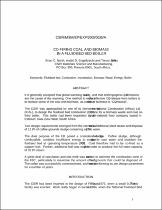JavaScript is disabled for your browser. Some features of this site may not work without it.
- ResearchSpace
- →
- Research Publications/Outputs
- →
- Conference Publications
- →
- View Item
| dc.contributor.author |
North, Brian C

|
|
| dc.contributor.author |
Engelbrecht, AD

|
|
| dc.contributor.author |
Hadley, TD

|
|
| dc.date.accessioned | 2007-08-22T06:52:40Z | |
| dc.date.available | 2007-08-22T06:52:40Z | |
| dc.date.issued | 2005-11 | |
| dc.identifier.citation | North, BC, Engelbrecht, AD and Hadley, TD. 2005. Co-firing coal and biomass in a fluidised bed boiler. IFAS 2005 - SAIMM Conference, 05 November 2005, pp 16 | en |
| dc.identifier.isbn | 1-919783-83-0 | |
| dc.identifier.uri | http://hdl.handle.net/10204/1145 | |
| dc.description | IFAS 2005 - SAIMM Conference | en |
| dc.description.abstract | It is generally accepted that global warming is a reality, and that anthropogenic CO2 emissions are the cause of the warming. One method to reduce the effective CO2 release from boilers is to replace some of the coal with biomass, as combustion of biomass is “CO2 Neutral”. The CSIR was approached by one of its licensees, International Combustion (Africa) Ltd (ICAL), to design the fluidised bed combustion (FBC) zone for a biomass waste and coal co-fired boiler. This boiler had been requested by a multi-national food company based in Estcourt, Kwa-Zulu Natal, South Africa. Two design requirements emerged from the clients needs: Additional plant steam and disposal of 12 t/h of coffee grounds sludge containing up to 87% water. The dual purpose of the FB posed a considerable challenge. Coffee sludge, although combustible, contains insufficient energy to evaporate its own water and maintain the fluidised bed at operating temperature (900 Degrees Celsius ). Coal therefore had to be co-fired as a support fuel. Further, additional fuel was required in order to produce the full rated capacity of 26 t/h steam. A great deal of calculation and test work was carried out to optimise the combustion zone of the FBC, particularly to maximise the amount of coffee grounds that could be disposed of. The boiler was successfully commissioned, and has been performing as per design parameters for a number of years. | en |
| dc.language.iso | en | en |
| dc.subject | Fluidised bed | en |
| dc.subject | Combustion | en |
| dc.subject | Incinerators | en |
| dc.subject | Biomass | en |
| dc.subject | Waste | en |
| dc.subject | Energy | en |
| dc.subject | Boiler | en |
| dc.subject | IFAS 2005 - SAIMM Conference | en |
| dc.title | Co-firing coal and biomass in a fluidised bed boiler | en |
| dc.type | Conference Presentation | en |
| dc.identifier.apacitation | North, B. C., Engelbrecht, A., & Hadley, T. (2005). Co-firing coal and biomass in a fluidised bed boiler. http://hdl.handle.net/10204/1145 | en_ZA |
| dc.identifier.chicagocitation | North, Brian C, AD Engelbrecht, and TD Hadley. "Co-firing coal and biomass in a fluidised bed boiler." (2005): http://hdl.handle.net/10204/1145 | en_ZA |
| dc.identifier.vancouvercitation | North BC, Engelbrecht A, Hadley T, Co-firing coal and biomass in a fluidised bed boiler; 2005. http://hdl.handle.net/10204/1145 . | en_ZA |
| dc.identifier.ris | TY - Conference Presentation AU - North, Brian C AU - Engelbrecht, AD AU - Hadley, TD AB - It is generally accepted that global warming is a reality, and that anthropogenic CO2 emissions are the cause of the warming. One method to reduce the effective CO2 release from boilers is to replace some of the coal with biomass, as combustion of biomass is “CO2 Neutral”. The CSIR was approached by one of its licensees, International Combustion (Africa) Ltd (ICAL), to design the fluidised bed combustion (FBC) zone for a biomass waste and coal co-fired boiler. This boiler had been requested by a multi-national food company based in Estcourt, Kwa-Zulu Natal, South Africa. Two design requirements emerged from the clients needs: Additional plant steam and disposal of 12 t/h of coffee grounds sludge containing up to 87% water. The dual purpose of the FB posed a considerable challenge. Coffee sludge, although combustible, contains insufficient energy to evaporate its own water and maintain the fluidised bed at operating temperature (900 Degrees Celsius ). Coal therefore had to be co-fired as a support fuel. Further, additional fuel was required in order to produce the full rated capacity of 26 t/h steam. A great deal of calculation and test work was carried out to optimise the combustion zone of the FBC, particularly to maximise the amount of coffee grounds that could be disposed of. The boiler was successfully commissioned, and has been performing as per design parameters for a number of years. DA - 2005-11 DB - ResearchSpace DP - CSIR KW - Fluidised bed KW - Combustion KW - Incinerators KW - Biomass KW - Waste KW - Energy KW - Boiler KW - IFAS 2005 - SAIMM Conference LK - https://researchspace.csir.co.za PY - 2005 SM - 1-919783-83-0 T1 - Co-firing coal and biomass in a fluidised bed boiler TI - Co-firing coal and biomass in a fluidised bed boiler UR - http://hdl.handle.net/10204/1145 ER - | en_ZA |






